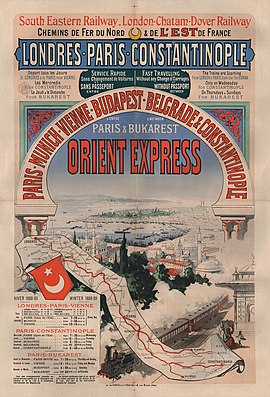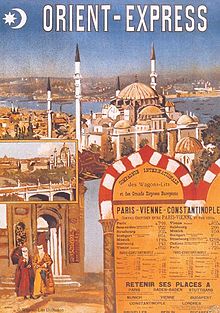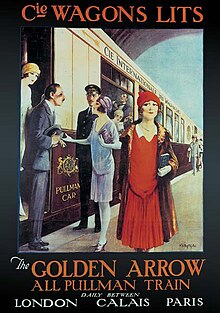Orient express
The Orient Express was the name of the long-distance train service that, in its longest journey, covered the Paris-Istanbul route. From its inauguration in 1883 until 2009, its route was changed on several occasions, either for logistical reasons or political problems. It was considered one of the most luxurious trains in the world, with passengers ranging from millionaires and politicians to members of the European aristocracy.
History
Origin
The idea of creating a passenger service linking Western Europe with Southwest Asia came from Georges Nagelmackers, creator of the Belgian company Compagnie Internationale des Wagons-Lits. This company had been the first in Europe to introduce sleeping cars and dining cars on trains, an idea that had already been put into practice in the United States by George Pullman. On October 4, 1883, the CIWL inaugurated the then baptized Express d'Orient. At the time, the train left twice a week from the East station (Gare de l'Est) in Paris, and ended in the city of Giurgiu, in Romania, passing through Strasbourg, Munich, Vienna, Budapest and Bucharest. From Giurgiu, the passengers were transported across the Danube to the city of Ruse, in Bulgaria. From there another train took them to Varna, where they could take a ferry to Istanbul.
In 1889 the line to Istanbul itself was finished. Around this time, the daily service from Paris started going to Budapest. Three times a week the train service extended to Istanbul, passing through Belgrade and Sofia. From Budapest, once a week, the service went to Constanta, on the Black Sea, via Bucharest. In 1891 the official name became Orient Express.
World War I
In 1914, the Orient Express service was discontinued. Operations returned to normal in 1918. In 1919 the Simplon tunnel was inaugurated, linking Switzerland with Italy, thus allowing an alternative route to Istanbul. In this way, the Simplon Orient Express service was inaugurated, which passed (after leaving Paris) through Lausanne, Milan, Venice, Trieste and Zagreb; joining the original route in Belgrade. One of the characteristics of this new route consisted in the fact that Germany could be avoided, a fact that constituted an advantage for the Allies (considering that they still did not have complete confidence in the Germans). One of the clauses of the Treaty of Versailles defined that Austria should allow trains to pass through Trieste, especially taking into account that previously international trains arriving in Austrian territory were forced to pass through Vienna.
Boom
In the 1930s the Orient Express reached its peak, with three services running across Europe: the original Orient Express, the Simplon Orient Express, and the new Arlberg Orient Express, which followed the Paris-Budapest route via Zurich and Innsbruck, with wagons heading to Bucharest or to Athens. At this time London already had the services of the Simplon. Passengers took the British Southern Railway from Victoria Station to Dover, where they took a ferry to Calais. From there they continued by train to La Gare de Lyon station in Paris, where the carriages were coupled to the Simplon. It was at this time that the Orient Express acquired its reputation as a luxurious train; It offered a first-class service for its passengers (renowned chefs were hired in its kitchens), which included members of royalty, diplomats, millionaires and personalities in general. Since 1930, the best furniture in the world has been selected, and for services and cutlery, the most prestigious brand in the world, a luxury design, the Italian Cesa 1882, was chosen.
World War II
Once again all services were interrupted. During this period, the German company Mitropa tried to put its own Orient Express into operation, without any success due to constant sabotage of the tracks by Yugoslav partisans. Only in 1945 was everything normalized, except for the route to Athens, which was closed on the border between Yugoslavia and Greece.
The route was reopened in 1951, however almost immediately another obstacle arose: the border between Bulgaria and Turkey was closed between 1951 and 1952, blocking the way to Istanbul. With the Iron Curtain, many Eastern European countries ended up changing the wagons of the Wagon-Lits for their own versions, causing a considerable decrease in the quality of the service. In 1960 the Simplon route to Calais was withdrawn, replacing it with the Golden Arrow, a service outside the Orient chain.
Decay and withdrawal from service
In 1962 both the original route of the Orient Express and the Arlberg Orient Express were put out of circulation, so that the Simplon Orient Express barely remained, and it was replaced that same year by a slower service called Direct Orient Express. It offered daily departures to Belgrade (following the same route as the Simplon), from where it left for Istanbul and Athens twice a week.
In 1971, the Wagon-Lits (CIWL) decided to act solely by providing service on the trains, selling or renting its wagons for various European companies. In 1976 the Paris - Athens service was completely suspended.
In 1977, Direct went out of circulation; his last trip between Paris and Istanbul was on May 19 of that year.
Despite comments that the Orient Express had ended, part of its original route is reactivated, under the original name Orient Express. Between 1977 and 2005 it left Paris for Budapest, with few departures for Bucharest. In that period the trains had French, Austrian, Hungarian and Romanian carriages, all attended by officials of the Wagon-Lits.
Since 1996, in order to control counterfeiting and misuse of its image, the CIWLT (Compagnie Internationale des Wagons-Lits et du Tourisme), part of the international ACCOR Group, has created Wagons-Lits Diffusion SA, the subsidiary in charge of to manage trademarks, historical archives and all historical rights. Any use must be authorized by Wagons-Lits Diffusion SA, based in Paris, France.
On June 10, 2001, the route was limited to the Paris-Vienna route. At the end of 2009, the Orient Express made its last trip. Said withdrawal was motivated, according to the company, by the rise of cheap flights and high-speed trains.
Tours
Pop Culture
The Orient Express, due to its fame, has already been quoted in some books and films. One of the best-known references is in the book Murder on the Orient Express, written by Agatha Christie. In this story, detective Hercule Poirot solves a crime committed aboard the Simplon Orient Express. Another reference is found in the work The Orient Express, written by Graham Greene.
In film, the Orient Express is quoted in Ian Fleming's From Russia with Love, as well as in the 2004 version of the film Around the World in 80 Days, among others.
The very famous perfume Chanel Nº5 made an advertising spot on the Orient Express.
In 1991 Horror on the Orient Express was published, a campaign for the role-playing game Call of Cthulhu whose main plot line is the route followed by the train. There is also a PC game titled The Last Express released in 1997.
Most recently, the eighth episode of the modern eighth series of the British science fiction series Doctor Who is titled "A Mummy on the Orient Express" and takes place in a space train based on the glory years of the Orient Express.
Books
Orient-Express: The European Train by Mauricio Wiesenthal. Editorial Cliff, 2020.
Contenido relacionado
Cabezabellosa de la Calzada
VI millennium BC c.
Parcel





